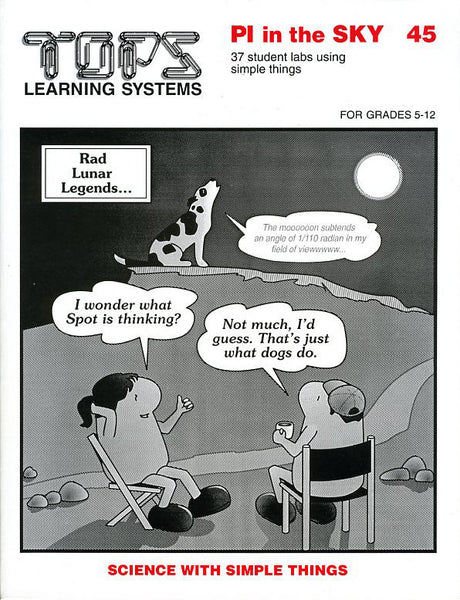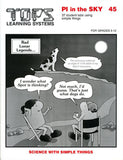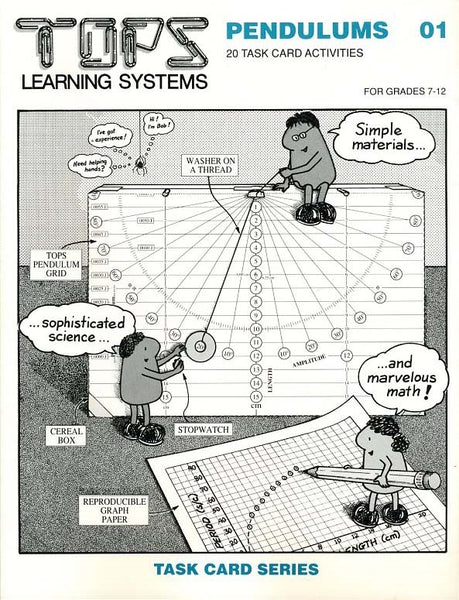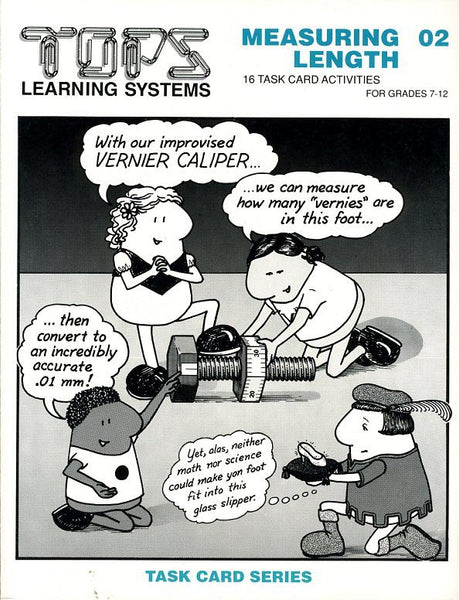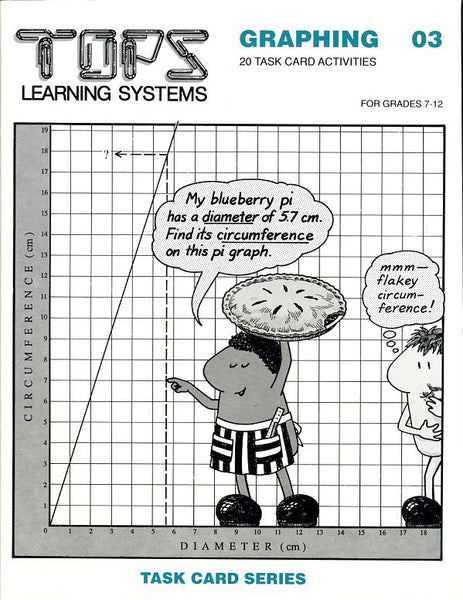#45 Pi in the Sky (grades 5-12)
Regular price $23.95
Soft-bound, 80 page book, 37 reproducible task cards, full teaching notes.
Scrap one-size-fits-all lessons! Choose from a variety of creative science and math labs and learning systems to appropriately challenge a wide range of skill levels. Discover how astronomers use pi to determine the size and distance of heavenly objects. Investigate radian angles, visual acuity and parallax. Build an ancient navigational instrument. This book is produced in partnership with NASA to inform students about the Fermi Gamma-Ray Space Telescope (formerly called GLAST), launched in June 2008.
More Information – click any of the tabs below to learn more about this title
Click here for a complete list of materials and convenient shopping.
FREQUENT USE
ruled notebook paper
pencils with good erasers
calculators (scientific calculators are optional)
* paper plates, generic, 9 inch diameter
scissors
string
* masking tape
* clear tape
meter sticks
index cards
OCCASIONAL OR SINGLE USE
metric ruler
drawing compass
* thread
* straight pins
size-D battery, dead or alive
* straws
* hand lenses
coins (U.S. pennies, nickels, quarters)
* clay
dark construction paper (black, dark blue, etc.)
standard hole punch
corrugated cardboard
current calendar with moon phases
small jars or cans
box or grocery bag to carry stuff
packaging tape
broom
clip board for recording observations outside
mirror (optional)
FREQUENT USE
ruled notebook paper
pencils with good erasers
calculators (scientific calculators are optional)
* paper plates, generic, 9 inch diameter
scissors
string
* masking tape
* clear tape
meter sticks
index cards
OCCASIONAL OR SINGLE USE
metric ruler
drawing compass
* thread
* straight pins
size-D battery, dead or alive
* straws
* hand lenses
coins (U.S. pennies, nickels, quarters)
* clay
dark construction paper (black, dark blue, etc.)
standard hole punch
corrugated cardboard
current calendar with moon phases
small jars or cans
box or grocery bag to carry stuff
packaging tape
broom
clip board for recording observations outside
mirror (optional)
A. TO VERIFY: The diameter of a circle fits into its circumference pi times.
1. Calculate the ratio C/D for different sized circles. Lo and behold, you always get about 3.14!2. Every circumference divides into 3.14 diameters (pi) and 6.28 radii (2pi).
3. How many different ways can you show that pi equals about 3.14?
4. Graph circumference as a function of diameter for circles large and small. What's the slope?
5. How much farther does it take GLAST to orbit the Earth than for you to walk around it?
B. TO UNDERSTAND: One radius of arc subtends a central angle of 1 radian (57.3°): pi radii subtend pi radians (180°); 2pi radii subtend 2pi radians in a full circle.
1. A paper plate, some simple measurements, a few snips.... Aha! So that's a radian!
2. Lay a triangle with 60° corners on a circle. Does this match a radian angle?
3. With a flexible ruler, measure 1-radius arc lengths around a circle circumference. Spot a genuine pi radian!
4. Count millimeter beads to deduce that pi radians of arc subtend a central angle of 180°. It all adds up.
5. The relationship between degrees and radians is direct and obvious. Fractional pi radians aren't quite so scary.
6. These puzzles could be tough -- unless you recall that 1 radius of arc subtends 1 radian: that pi rad subtend 180°.
7. This exercise is a good review of fractions. The angles are a bit weird, but everything adds up to pi/2 rad or 90°.
C. TO GENERALIZE:Any object "n" diameters from your eye (n>5), subtends an angle of 1/n radians at your eye.
1. Notice how the coin-diameter ruler measures distance in diameters and angles in radians for pennies, nickels and quarters.
2. See how a penny looks half as tall when placed twice the number of penny-diameters from your eye.
3. Observe how a penny, nickel and quarter appear to be the same size when placed equal coin diameters from your eye.
4. Understand that any object "n" diameters from your eye subtends 1/n radians in your field of view (n>5).
5. Correlate nickel diameters on your Coin Ruler with plate diameters on your Plate Ruler.
6. Make a Moon Ruler. Correlate its size with our real Earth and Moon and the distance between.
7. Use your knowledge of radians and subtended angles to make a paper plate equal in angular size to your paper-punch moon.
8. Compare the actual size of the real moon to the psychological image we carry in our heads.
D. TO MEASURE: A weather balloon is visible up to 7,000 balloon-diameters away. At this distance it subtends 1/7000 rad or about 30 arc seconds in your field of vision. 1. How many millimeters back from a 1 mm dot can you stand and still make it out? This distance divided into 1 mm is your visual acuity in radians.
2. What works for a 1 mm dot works for smaller and larger test dots, too. Express radians as fractions with 1 in the numerator for maximum clarity!
3. Practice converting user friendly radians back into seconds, minutes and degrees.
4. Can you see a dime at 100 meters? Make a prediction, plan your experimental strategy, and report your conclusions.
E. TO DISCOVER: Any object with an apparent size of 1/D radians is D unit diameters from your eye. 1. Merge 1/10 radian (5.73°) and a meter stick at a distance of 10 meters. Consider the implications!
2. Practicing good posture, notice where to stand along a row of paper plates so Kamal and plate radian angles correspond.
3. Practice estimating apparent angular size using the edge calibrations on your Kamal. Improvise a Kamal with your thumb and outstretched arm.
4. Do this with a lab partner. Estimate her distance from you when she appears 1/10 radian tall next to your Kamal.
5. Work with a lab partner as before. Estimate his height with your Kamal at a distance of 30 meters.
6. Space the planets with your Kamal so the model Sun has the correct apparent size when viewed from each planet.
7. Collect moon data from the library or the net. Calculate the ratio of diameter to distance for all major moons in our solar system.
F. TO COMPUTE: Take Kamal readings. Use algebra to compute an object's actual size; use parallax to compute actual distance. No need to go there! 1. Take a Kamal reading. Move closer and take another reading. Solve simultaneous equations to estimate the diameter of a "remote" paper plate.
2. Find something tall outside. Estimate its height with your Kamal and clever math following three different strategies.
3. Watch the end of a meter stick "jump" back and forth relative to distant landmarks. Measure this parallax with your Kamal and with a ruler.
4. Set up a 1-meter baseline, positioned sideways to a "remote" tree or pole. Measure its parallax with your Kamal and calculate its distance.
5. Knowing the parallax shift of nearby Sirius against distant background stars, estimate how far away it is in astronomical units and light years.
6. Understand how a distance of one parsec is defined. Uses this definition to calculate the distance to Sirius in parsecs.
We encourage improvisation - it's one of the main goals of our hands-on approach! You and your students might invent a simpler, sturdier or more accurate system; might ask a better question; might design a better extension. Hooray for ingenuity! When this occurs, we'd love to hear about it and share it with other educators.
National Science Education Standards (NRC 1996)
Teachers of science...
A: ...plan an inquiry-based science program. (p. 30)
B: ...guide and facilitate learning. (p. 32)
C: ...engage in ongoing assessment of their teaching and of student learning. (p. 37)
D: ...design and manage learning environments that provide students with the time, space, and resources needed for learning science. (p. 43)
• Represent a central event or phenomenon in the natural world.
• Represent a central scientific idea and organizing principle.
• Have rich explanatory power.
• Guide fruitful investigations.
• Apply to situations and contexts common to everyday experiences.
• Can be linked to meaningful learning experiences.
• Are developmentally appropriate for students at the grade level specified.
Core Concepts/Processes: Objects appear as large as the angle they subtend in your field of view. Thus, you can hide the Sun with your thumb.
Core Inquiries: Estimate the angular size of the moon in radians. Does it really seem that small?
Core Content: Create simple instruments that measure the apparent angular size of distant objects. • Estimate real size and real distance as astronomers do. • Understand the geometry of subtended angles; the astronomy of apparent size.
Core Content: Ancient Arabian navigators sailed north or south until their Kamal (a rectangle of wood on a knotted string) fit perfectly between Polaris and their horizon. Then they "sailed their latitude" to home port.
TEACHING Standards
These 37 labs promote excellence in science teaching by these NSES criteria:Teachers of science...
A: ...plan an inquiry-based science program. (p. 30)
B: ...guide and facilitate learning. (p. 32)
C: ...engage in ongoing assessment of their teaching and of student learning. (p. 37)
D: ...design and manage learning environments that provide students with the time, space, and resources needed for learning science. (p. 43)
CONTENT Standards
These 37 labs contain fundamental content as defined by these NSES guidelines (p. 109).• Represent a central event or phenomenon in the natural world.
• Represent a central scientific idea and organizing principle.
• Have rich explanatory power.
• Guide fruitful investigations.
• Apply to situations and contexts common to everyday experiences.
• Can be linked to meaningful learning experiences.
• Are developmentally appropriate for students at the grade level specified.
Unifying Concepts and Processes
NSES Framework: Systems, order, and organization • Evidence, models and explanation • Constancy, change, and measurementCore Concepts/Processes: Objects appear as large as the angle they subtend in your field of view. Thus, you can hide the Sun with your thumb.
Science as Inquiry (content standard A)
NSES Framework: Identify questions that can be answered through scientific investigations. • Design and conduct a scientific investigation. • Use appropriate tools and techniques to gather, analyze, and interpret data. • Develop descriptions, explanations, predictions, and models using evidence. • Think critically and logically to connect evidence and explanations. • Recognize and analyze alternative explanations and predictions. • Communicate scientific procedures and explanations. • Use mathematics in all aspects of scientific inquiry.Core Inquiries: Estimate the angular size of the moon in radians. Does it really seem that small?
Earth and Space Science (content standard D)
NSES Framework: Objects in the sky • Changes in earth and sky • Earth in the solar systemCore Content: Create simple instruments that measure the apparent angular size of distant objects. • Estimate real size and real distance as astronomers do. • Understand the geometry of subtended angles; the astronomy of apparent size.
History and Nature of Science (content standard G)
NSES Framework: Science as a human endeavor • History of scienceCore Content: Ancient Arabian navigators sailed north or south until their Kamal (a rectangle of wood on a knotted string) fit perfectly between Polaris and their horizon. Then they "sailed their latitude" to home port.

